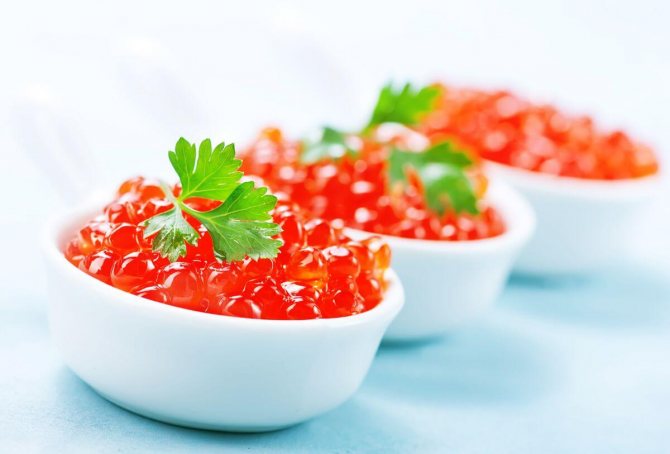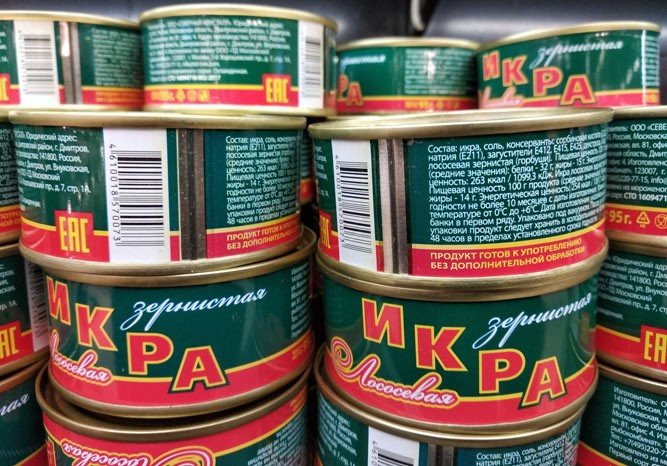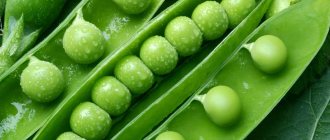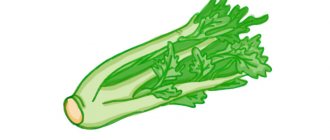A growing child's body requires protein, omega-3 fatty acids and other nutrients. Red caviar is a storehouse of natural protein, which is completely digestible by humans. The vitamin and mineral complex contained in this product strengthens the child’s health and ensures the correct functioning of all organs. Therefore, natural caviar can be included in your baby’s diet, but with reservations.
Photo: Depositphotos.com. author: Natasha Breen.
Composition and calorie content
The calorie content of the product depends on the type of red fish from which it is extracted.
The most nutritious is salmon caviar (263 kcal per 100 g). For comparison: pink and sockeye salmon caviar contains 230 kcal, and chum salmon caviar contains 250 kcal. The delicacy contains practically no carbohydrates. But it contains a lot of fat. True, most of them are polyunsaturated (omega-3 and omega-6), which are completely broken down during digestion.
The cholesterol present in the composition does not exceed acceptable levels. In addition, it is neutralized by lecithin, also present in red caviar.
The list of nutrients contained in the product and necessary for the child is shown in the table.
| Substance | Daily value for a child (from 3 to 6 years old) | Beneficial features |
| Protein | 3.5–4 g | Absorbed faster and in greater volume than protein from fermented milk products and meat |
| Iodine | 90 mg | Promotes normal functioning of the thyroid gland, which is also responsible for the normal development and growth of the child |
| Polyunsaturated fatty acids (PUFAs) | 5 g | Essential for healthy metabolism. Contained in a limited set of products, despite the fact that the child’s body is not able to synthesize them |
| Calcium | 900 mg | Strengthens bones and teeth, is a building element of growing structures of the musculoskeletal system |
| Phosphorus and manganese | 1000–1400 mg | Stimulates brain function |
| Potassium | 600 mg | Provides sodium-potassium balance, regulates cardiac activity |
| Sodium | 1000 mg | Like potassium, it is needed for normal cell function. Together they form the so-called sodium-potassium pump, which is of key importance for the body at the cellular level |
| Iron | 8 mg | Indispensable in the process of hematopoiesis, promotes the production of hemoglobin and, as a result, the supply of oxygen to all organs |
| Magnesium | 20 mg | Strengthens the nervous system, relieves anxiety, night terrors, fights tearfulness |
| Vitamin A | 400 mcg | Participates in the formation of healthy bones and hair, is necessary for the organs of vision and the functioning of the immune system |
| Vitamin D | 75 mcg | Prevents the development of rickets, regulates mineral metabolism, ensures normal growth |
| Vitamin E | 7 mcg | Participates in tissue regeneration, improves cell nutrition, increases the body's endurance, and has pronounced antioxidant properties. |
| B vitamins | B1 - 1.5 mg; B2 - 1.7 mg; B3 - 10 mg; B5 - 5 mg; B6 - 2 mg; B9 - 200 mcg; B12 - 6 mcg | Provide metabolism at the cellular level, contribute to the strengthening and development of the child’s nervous system, and participate in the transmission of nerve impulses |
Composition and value of caviar
- The product of this variety is obtained from salmon fish. Taste qualities force people to include caviar in the main menu of the table. But in addition to taste properties, the products are also famous for their excellent valuable qualities.
- It contains a lot of iodine, potassium, calcium, lecithin, unsaturated fatty acids, manganese and other minerals. The product also includes many vitamins, including B-group, ascorbic acid, tocopherol, vitamin D, vitamin PP, vitamin K.
- The main properties of caviar include the ability to increase thinking abilities by stimulating brain neurons. Along with this, it stabilizes the activity of the central nervous system and improves the psycho-emotional background. It contains a lot of iron, which is required to increase hemoglobin levels.
health benefits and harms of red caviar
Why caviar is good for children
Childhood is characterized by active growth and development of all systems. Advantages of introducing caviar into a child’s diet:
- strengthening the immune system;
- development and formation of brain functions;
- stabilization of the nervous system;
- bone development, formation of strong and healthy nails, hair and teeth;
- prevention of vision problems;
- hormonal balance due to normalization of the thyroid gland;
- regulation of gastrointestinal tract (GIT) functions.
Red caviar is a leader in the content of iodine, protein, and B vitamins. These nutrients in combination are difficult to find in other food products.
The pleasant taste and attractive appearance stimulate appetite, and the child enjoys the healthy delicacy with pleasure.
Properties of red caviar
The eggs of salmon and related fish species are rich in vitamins B, A, E and D. The product promotes better absorption of calcium, of which there is also a lot in the composition. The delicacy also contains lecithin, sodium, manganese, iodine, potassium, iron and phosphorus. These substances are necessary for the full formation of the nervous system, the functioning of the thyroid gland, normal blood circulation, and the health of the heart and blood vessels.

Possible harm to the baby
Not all children can eat red caviar. Contraindications are associated with the high salt content in the product, as well as possible individual intolerance.
Contraindications
Doctors do not recommend including the delicacy in your diet:
- for diabetes;
- with an increased risk of developing or existing heart disease;
- with impaired renal function;
- with food allergies to fish and seafood.
It is worth considering the calorie content. Excessive consumption, especially with butter, can lead to excess weight gain.
Side effects
Negative consequences after eating caviar are often associated with the purchase of a low-quality product. Some sellers are guilty of selling counterfeit products. The eggs are made from colored gelatin with additives. Such food is not beneficial to children's health.
The presence of preservative E239 (healing hormone) in the delicacy is undesirable. When ingested, it turns into a toxic substance that adversely affects the liver, kidneys and nervous system.
Allergy risk
A common reason for not including red caviar in a baby’s menu is an allergic reaction.
Red caviar is a strong allergen that provokes a negative reaction not always immediately after eating. This should be taken into account when introducing the product into a child’s diet.
After the first test, you should monitor the baby’s health for a couple of days. If there is no itching or rash, then the amount of the delicacy can be increased slightly.
Damage to calves
- The problem with the product in question is that it quite often causes an allergic reaction. The baby may have a rash. What is most interesting is that an allergic reaction does not always manifest itself at the first test. Therefore, carefully monitor your child’s condition after each use of raw materials.
- Most modern producers of red caviar add compounds that are harmful to children's bodies. Therefore, a baby’s reaction to a low-quality product can simply be unpredictable. If you decide to include caviar in your child’s diet, choose the product with special care.
Red caviar is undoubtedly necessary for the little gourmet’s body. But it should be introduced into the children's diet slowly in order to promptly identify a possible allergy and exclude the product from the diet. Remember that you cannot exceed the specified standards, otherwise the baby’s body simply will not assimilate this delicacy.
Is it possible to have red caviar while breastfeeding?
From what age
Since caviar is an allergen, and also due to the salt content in its composition, it is not recommended to give the product to a child under three years of age. Only when the digestive system is formed and the baby is transferred to the common table with the parents can one begin to introduce the delicacy into the diet.
- How to enter into the menu. It is recommended to start your acquaintance with a few eggs. After initial observation (provided there is no allergy), the amount can be gradually increased.
- How much to give? The optimal amount of red caviar for a child is no more than 2 tsp. in a day. In this case, it is better to avoid daily consumption. No more than twice a week is the best solution.
Doctors' opinion
Pediatricians agree on the benefits of seafood for children’s bodies, including red caviar.
Dr. Komarovsky has repeatedly explained that new foods in a baby’s diet are a necessity. If the age standards for the delicacy are observed and there are no contraindications, natural salmon caviar will only benefit the child’s health.
Doctors also explain that most of the territory of the Russian Federation is characterized by a deficiency of iodine and vitamin D. Regular consumption of red eggs can cover the need for these nutrients.
At what age can children eat shrimp?
Red caviar for children: benefits and harm
Children are the flowers of life! This is the slogan of modern society, since children are now important members of the family, although until the 17th century in Europe and almost until the 19th century in Russia, children were not considered people at all, they were only assistants to adults, both in youth and in old age . However, these times have passed and now a wide industry is dedicated to the production of all kinds of things for children. Maybe this is for the better, since children are an extension of life and by developing them, we can develop our society. So, let's move on to the most important topic for us, namely whether caviar is good or bad for children.
First, let's turn to the composition of caviar and find out which elements contained in it should be in the child's essential vitamin diet.
Protein. Red caviar contains more than 30% protein saturated with amino acids, which is very important for the child’s body, because This is a building, the construction of which is proceeding at a rapid pace, therefore, it also requires materials, one of which will be protein, and it will act as the foundation of the building of the child’s body.
Iodine. Red caviar, being a product of marine origin, necessarily contains iodine, which is also an important element for the child’s body. It regulates the activity of the thyroid gland. And the thyroid gland, in turn, regulates metabolism and energy. Iodine is also needed for the functioning of the brain, and with a lack of this substance, all sorts of malfunctions can occur in the functioning of the brain. It is important to remember that: Children under 6 years of age should receive 90 mg of iodine per day. Children from 6 years to 12 years old - 120 mg of iodine per day Children over 12 years old - 150 mg of iodine.
Iron. Iron plays a huge role for a child’s body! Decreased iron levels lead to the most common anemic syndrome, iron deficiency anemia. Since everyone knows that iron maintains the required level of hemoglobin in the blood, which in turn delivers oxygenated blood throughout the body. Red caviar contains 11.88 mg of iron. Children's need for iron by age: • up to one year – 7 mg per day; • 1-3 years – 8 mg per day; • 4-6 years – 8 mg per day; • 7-10 years – 10 mg per day; • 11-13 years – 15 mg per day; • 14-17 years – 15 mg per day.
Fat-soluble vitamins. These are vitamins A, D, E, which help strengthen the immune system, improve vision, and most importantly for children, strengthen and grow the bone skeleton!
Red caviar also contains: Vitamins A - 0.271 mg, B1 - 0.19 mg, B2 - 0.62 mg, B3 - 3.5 mg, B6 - 0.32 mg, B9 - 50 mcg, B12 - 20 mcg, D - 0.1724 mcg, E - 1.89 mg, K - 0.6 mcg, Choline - 490.9 mg. Microelements: Calcium - 275 mg, Magnesium - 300 mg, Sodium - 1500 mg, Potassium - 181 mg, Phosphorus - 356 mg, Zinc - 0.95 mg, Copper - 110 mcg, Manganese - 0.05 mg, Selenium - 65, 5 mcg
However, there are also contraindications: 1. Red caviar should not be consumed by children under 3 years of age, because the organs of the gastrointestinal tract are not fully formed. 2. Red caviar can cause allergic reactions in the form of a skin rash, so before including this product in your child’s diet, you should consult a pediatrician. 3. Red caviar, being a perishable product, inherently includes preservatives.
Thus, we come to the conclusion that red caviar is a necessary product for children, but in small quantities and only after consulting a doctor. And most importantly, only high-quality caviar is healthy, and you can order it here
How to choose

Photo: Sigaeva O.
When choosing a product for a children's table, carefully study the product packaging.
You can buy caviar:
- by weight;
- in a tin container;
- in a glass jar.
The weighted product can be better examined and even tasted. The only negative is the short shelf life. Provided salmon spawn in the summer, guaranteed healthy salmon caviar can only be purchased until November.
Tin cans do not allow the eggs to be seen and can be dangerous for the child’s body. For example, some manufacturers treat containers with bisphenol. Once in the body, it provokes the development of cancer cells, disruption of the heart, kidneys and nervous system.
The best choice is caviar in a glass jar. It reliably preserves the freshness of the delicacy and allows you to see the eggs in the light.
The eggs of a quality product are smooth, without dents or stains. When opening the package, the smell of the product should not be sharp or strongly fishy.
Varieties
Red caviar differs according to the variety of source fish:
- Pink salmon is one of the budget categories of caviar, since the fish is not considered rare and spawns abundantly. Medium-sized bright orange caviar. Despite the low price, it is considered one of the most useful.
- Chum salmon is larger, also bright orange, has an attractive and appetizing appearance, so it remains a favorite for festive table setting.
- Coho salmon is a dark red caviar with an original, slightly bitter taste.
- Trout - light, small eggs.
- Sockeye salmon is a premium variety. The high cost is due to the rarity of the fish.
Attention! Chinook salmon is listed in the Red Book, its fishing is prohibited by law. Therefore, the sale of caviar from this fish is criminally punishable.
How to spot a fake
It is sometimes difficult to distinguish synthetic caviar from natural one.
Some tips for seafood lovers:
- artificially produced eggs are denser, stick to the teeth and do not burst easily;
- the synthetic product does not have the embryonic eye characteristic of natural eggs;
- By placing gelatin caviar in water, you can notice the coloring of the liquid.
Focus on the cost - a fake is much cheaper than a natural delicacy.
Ideas with a beautiful presentation
Kids love it when food is something interesting. This dish is eaten with pleasure without leaving a trace. Red caviar is perfect for decorating, for example, mashed potatoes or omelettes. Simply sprinkle some brightly colored eggs on the dish, and it will become much more attractive to the child.
Calling on your imagination to help, you can put figures, houses, cats, funny mouse faces, etc. on sandwiches.
Or bake the potatoes in the oven and serve them, garnished with caviar. To prepare, just wrap the potatoes in foil and place in a preheated oven for half an hour. After that, cut it in half and use a spoon to make small indentations, which you fill with caviar, sour cream and herbs.
Children love pancakes stuffed with red caviar, as well as cheese and egg sandwiches decorated with caviar.
Reviews from parents
Elena. My tomboys love red caviar. Most of all I like pancakes and sandwiches. We buy caviar not only for the holiday table, but also treat ourselves at family dinners. Anastasia. My daughter and I prefer salmon caviar for breakfast. I love sandwiches with a cup of coffee, and Ksyusha eats them with tea. I think it’s better to give your child natural products, and not just stuff him with vitamin complexes. Caviar provides the need for omega-3, iodine and vitamins, so it is loved in our family.
Catherine. At first, when Lyosha was very small, I was afraid to eat caviar myself. I thought that breastfeeding might trigger an allergy. When the pediatrician advised me to try including it in my diet, I took a risk and didn’t regret it at all. Now that my son has grown up, he already eats the delicacy with omelettes and sandwiches without side effects.
Irina. We regularly buy red fish caviar for delicious, hearty breakfasts and to maintain health. The lack of iodine in our region has a detrimental effect on the thyroid gland, so I prefer to play it safe. Children are delighted with pancakes with caviar, and also love it with potatoes and simply on toast.
At what age can a child be given mackerel?











